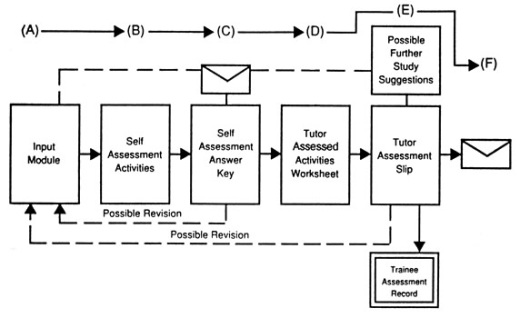A Guide to Distance English Language Teaching Programmes
Brian Winn-Smith, UK
Brian Winn-Smith is the director of Eurolink Courses, UK.
E-mail: brian@eurolinkcourses.co.uk
Menu
Introduction
How a good distance programme might be organised
Set books for such a course
On the right track
Helping to reduce the loneliness of the distance learner
What is ACTDEC and what does it do?
ACTDEC organisation structure and board
Which programme — which path?
Advanced Teaching Practice
Teaching Practice Scheme
Summing up
To meet the current demand for distance ELT courses many language schools and colleges have recently entered this field. Some offer substantial courses mirroring the best programmes offered on a face-to-face basis. Sadly however, this is not always the case. Many distance programmes tend to be rather limited and often fail to cover the training as thoroughly as they might. Cutting corners may produce cheaper programmes but often fail to provide the required standard of training enabling the learner to teach well. One may not realise just how sophisticated good current distance programmes can be. Best avoided is the distance programme of mostly text requiring limited written feedback. Consider the programme below shown in diagrammatic form which is really thorough and prepares students well for the teaching task ahead.
With only one or two exceptions each module of every unit follows much the same format. A module typically consists of four elements. The first stage (A) comprises an input module and a series of self-assessment exercises (B). After completing the exercises, but not before, one should consult the answer key (C) to check the answers and, where necessary, revise the work completed. In the next stage (D) students complete and post the tutor-assessed worksheet to the unit tutor for assessment, comment and grading. The tutored and graded worksheet plus the tutor assessment slip (E) is then returned to students (F). Please see the diagram below.

It would be difficult to imagine a substantial programme, such as the one described above, that made no reference to essential reading however limited. Try to imagine a university level course that had no prescribed reading for those following such a programme.
If one successfully completes a course accredited by ACTDEC (the Accreditation Council for TESOL Distance Education Courses) one can be sure to follow such a programme as outlined above.
Long experience has made many aware of the loneliness and uncertainty sometimes felt by the geographically distant learner and the occasional feeling of isolation experienced.
At least two methods of helping to overcome any such problems are suggested.
The first involves bringing course members together through a 'Getting in touch' scheme. Enclosed with the course handbook a course member should find a biographical notes form to complete and return to the course provider. Upon receipt and with students’ permission, the course provider will photocopy and send it together with the other completed notes to everyone — thus providing the means for all course members to get in touch with each other if they so wish.
The second suggestion involves working in tandem possibly with another trainee; perhaps someone living not too distant. This is not, of course, a suggestion that a student should work with someone else to complete the module self-assessment exercises but quite simply to check each others work. Having completed the module's self-assessment activities a student could pass or post the module to their 'work-partner' without opening the sealed answer key, and only opening the key after having received their partner's completed module exercises. Getting someone else to correct the 'self-assessment’ work tends to ensure that students tackle the work fully, and helps avoid half-hearted, hurried or incomplete answers and exercises. This may help encourage students to complete the work as if it were being done as part of a face-to-face session for a tutor to read, correct and comment on. The result, usually, is a more diligent approach to the work and, of course, a faster and increased learning curve.
Yet another possibility, and attractive to many trainees, is to persuade a member of their family or a close friend to fulfil the rôle of 'assessment-partner'. Since all the answers to the self-assessment questions are relatively short there is little room for ambiguity or doubt and the assessor needs to know little about the subject matter. Where any explanation on students’ part is necessary, this can only prove helpful in reinforcing concepts and ideas through discussion and exposition.
The tutor-assessed worksheet should, of course, be completed by each trainee working alone since the worksheet of each module is an assessed piece of work.
In recent years, the Internet has brought with it many new possibilities for communication: instant messaging, online chat, forums, newsgroups, news feeds, VOIP telephones and not forgetting the now ubiquitous e-mail.
Some distance course providers offer a web forum or other similar facilities for students to contact each other as well as their tutors.
The Accreditation Council for TESOL Distance Education Courses is a non-profit making independent body governed by officers and Council, established to advance professionalism by maintaining and also improving on standards of distance programmes at four levels graded from introductory to advanced. Institutions providing accredited courses are required to adhere to a rigorous code of practice governing areas ranging from publicity to course structure and content, administration, course evaluation and quality assurance. ACTDEC accredited courses are regularly audited to ensure that quality expectations are being met. A copy of the code of practice is available by contacting ACTDEC.
ACTDEC was founded in 1992 by a small group of TESOL distance education providers concerned by the considerable number of organisations offering dubious TEFL/TESOL distance learning courses.
ACTDECs first Chair, and one of its driving forces, was Dr W.R. Lee, founder of IATEFL, who was also responsible for its Code of Practice and accreditation procedures. The courses and qualification levels framework was originally proposed by Monica Vincent of the Overseas Development Authority. The titles she suggested were subsequently adopted by ACTDEC.
ACTDEC has an Advisory Committee which consists of its patron:
Professor Arthur van Essen MA, MA, PhD.
Officer in the Order of Orange-Nassau
Professor Emeritus: Applied Linguistics and Teacher Training
Chair of ACTDEC:
Kenneth Milgate BA(Hons), MIL, MA, M.Ed, Dip.FE, FCollT(TESOL)
Coordinating Council consisting of a Legal Advisor, Treasurer and Chair of the Membership Committee who are also members of the Advisory Committee.
Each year the ACTDEC Annual General Meeting takes place in London at the English Speaking Union in Mayfair and open to all full accredited members wishing to attend.
Website: www.ACTDEC.org.uk
If you are a new entrant to the TESOL profession and have no teaching experience you can start by following a Certificate in TESOL distance-training programme.
There is, of course, no substitute for teaching practice. In the case of experienced practising teachers it is not always necessary though we do very much hope that students will be able to find time to attend one of the two-week residential teaching practice blocks in Gran Canaria, Spain and so convert their Certificate programme to an Advanced Certificate in TESOL.

However, ACTDEC – the Accreditation Council for TESOL Distance Education Courses – suggest there is no reason why teaching practice should not follow distance-training; quite the opposite!
For anyone without teaching experience it is now possible to undertake a one or two-month teaching development practicum abroad where, through the completion of a Teaching Practice Portfolio maintained by the student and the institution where s/he is employed, his/her teaching experience is recognised and rewarded through accreditation of their expertise.
This scheme makes it possible for teachers with Associate or Accredited Teacher status to obtain an ACTDEC Certificate of Teaching Practice Development at the end of the two-month development practicum.
Any school can sponsor an applicant providing they are able to meet the following criteria.
- The sponsoring school is able to offer a minimum of six hours supervised teaching practice during the first month and ten hours observed and assessed teaching practice during the remainder of the practicum.
- The school is able to provide documentary evidence of recognised professional standing in the locality.
- The school employs at least one full-time senior teacher holding a recognised TESOL/TEFL diploma. (A list of recognised diplomas can be obtained from ACTDEC.)
- The sponsoring school is prepared to abide by the principles and procedures laid down by the ACTDEC Council governing the teaching practice development scheme.
When a student has located a suitable sponsoring school, they simply contact the ACTDEC Registrar who will send them a form to complete and make the necessary arrangements.
Many schools at home and abroad are very willing, and able, to provide teaching practicums for distance-trained teachers, who usually have a much greater depth of TESOL knowledge than those who have completed only a four-week course of training. As such, professionally distance-trained teachers who have followed an accredited course, are greatly valued.
TESOL distance programmes and training that prepare you to teach all ages effectively should include:
- A programme comprising several topic areas, e.g. study skills, linguistics, phonetics and phonology, the practice of TESOL and language awareness.
- Thoughtful, carefully constructed distance programmes comprising input modules with self-assessment activities, answer keys, tutor assessed activities with regular tutor feedback.
- Input material and exercises designed to act as an important learning ladder.
- Coursework features include regular, systematic progress including the latest trends in TESOL activities.
- The nature and use of phonetics and phonology explained.
- Course modules supplemented by audio input.
- Highly qualified specialist tutors assigned to all students. Their task is to guide and help students through the programme as well as marking and grading their work.
- A tutorial system to keep students in constant touch with tutors able to respond to queries and provide help and regular advice.
If this information has proved interesting and informative and you’d like to know more, then please go to our website atwww.eurolinkcourses.co.uk
or
www.traininglinkonline.co.uk for online-delivered courses.
free newsletter
A regular monthly newsletter for teachers working in the field of TESOL is available. If you’d like to view and subscribe to the newsletter, simply visit www.eurolinkcourses.co.uk/news

Please check the What’s New in Language Teaching course at Pilgrims website.


|